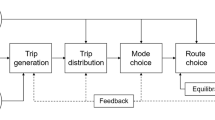Abstract
Many problems in transport planning and management tasks require an origindestination (O-D) matrix to represent the travel pattern. However, O-D matrices obtained through a large scale survey such as home or roadside interviews, tend to be costly, labour intensive and time disruptive to trip makers. Therefore, the use of low cost and easily available data is particularly attractive.
The need of low-cost methods to estimate current and future O-D matrices is even more valuable in developing countries because of the rapid changes in population, economic activity and land use. Models of transport demand have been used for many years to synthesize O-D matrices in study areas. A typical example of this is the gravity model; its functional form, plus the appropriate values for the parameters involved, is employed to produce acceptable matrices representing trip making behaviour for many trip purposes and time periods.
The work reported in this paper has combined the advantages of acceptable travel demand models with the low cost and availability of traffic counts. Three types of demand models have been used: gravity (GR), opportunity (OP) and gravity-opportunity (GO) models. Three estimation methods have been developed to calibrate these models from traffic counts, namely: non-linear-least-squares (NLLS), weighted-non-linear-least-squares (WNLLS) and maximumlikelihood (ML).
The 1978 Ripon (urban vehicle movement) survey was used to test these methods. They were found to perform satisfactorily since each calibrated model reproduced the observed O-D matrix fairly closely. The tests were carried out using two assignment techniques, all-or-nothing and the stochastic method due to Burrell, in determining the routes taken through the network.
Similar content being viewed by others
References
Box GEP & Cox DR (1964) An analysis of transformations. Journal of Royal Statistical Society 26B: 211–243
Burrell JE (1968) Multiple route assignment and its application to capacity restraint. Proceeding of the Fourth International Symposium on the Theory of Traffic Flow, Karlsruhe 1968
Edwards AWF (1972) Likelihood. Cambridge University Press, Cambridge
Hamerslag R & Immers LH (1988) The estimation of trip matrices: Shortcomings and possibilities for improvement. Faculty of Engineering, TU Delft
Högberg P (1976) Estimation of parameters in models for traffic prediction: a non-linearregression approach. Transportation Research 10(4): 263–265
Holm J et al. (1976) Calibrating traffic models on traffic census only. Traffic Engineering and Control 17(4): 137–140
Low DE (1972) A new approach to transportation systems modelling. Traffic quarterly 26(3): 391–404
Robillard P (1975) Estimating the O-D matrix from observed link volume. Transportation Research 9(2/3): 123–128
Smith DP & Hutchinson BG (1981) Goodness of statistics for trip distribution models. Transportation Research 15A(4B): 295–303
Steer Davies & Gleave Ltd (1984) MOTORS Transportation Suite: User Manual, London
Tamin OZ (1985) Estimation of matrices for freight movement from traffic counts using a non-linear regression approach. Special study for the degree of MSc of the University of London, Imperial College and University College London (unpublished)
Tamin OZ (1988) The estimation of transport demand models from traffic counts. PhD thesis, Transport Studies Group, University College London, University of London
Van Zuylen HJ & Willumsen LG (1980) The most likely trip matrix estimated from traffic counts. Transportation Research 14B(3): 281–293
Wills MJ (1986) A flexible gravity-opportunities model for trip distribution. Transportation Research 20B(2): 89–111
Willumsen LG (1978) Estimation of an O-D matrix from traffic counts—a review. Working Paper no. 99, Institute for Transport Studies, University of Leeds
Willumsen LG (1981) Simplified transport models based on traffic counts. Transportation 10(3): 257–278
Willumsen LG (1984) Estimating time-dependent trip matrices from traffic counts. Proceedings of the Ninth International Symposium on Transportation and Traffic Theory, Delft (pp 397–411)
Wilson AG (1967) A statistical theory of a spatial distribution models. Transportation Research 1: 253–269
Author information
Authors and Affiliations
Additional information
requests for offprints
Rights and permissions
About this article
Cite this article
Tamin, O.Z., Willumsen, L.G. Transport demand model estimation from traffic counts. Transportation 16, 3–26 (1989). https://doi.org/10.1007/BF00223044
Issue Date:
DOI: https://doi.org/10.1007/BF00223044




